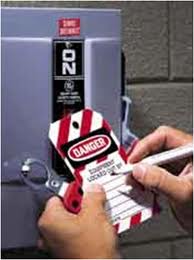
Lockout tagout definition. Lockout tagout (LOTO) is the procedure to ensure equipment cannot be operated during equipment maintenance or repair. It is a crucial safety measure to prevent the unexpected energization or start-up of machines or service equipment or the release of stored energy that could cause injury to employees. Compliance with the lockout tagout standard ensures full employee protection, prevents fatalities and injuries, and safeguards workers in hazardous environments.
Visit our Lockout Tagout Training Page
Remember that lockout tagout definition is not just about the placement of lock and tag devices on equipment. To meet the definition, it also requires a comprehensive energy control plan and authorized employee training to enforce compliance with OSHA requirements. Companies must prioritize the safety of their workers by implementing and adhering to the LOTO procedure.
The placement of a lock device on an energy-isolating device is called lockout, while the placement of a tag device on an energy-isolating device is called tagout. Lockout tagout definition, according to OSHA standard Reg. 29 CFR 1910.147 and CSA Z460, is the procedure to ensure a piece of equipment cannot be operated during equipment maintenance or repair. This standard covers the servicing and maintenance of machines and equipment in which the unexpected energization or start-up of the machines or equipment, or release of stored energy could cause injury to employees.
The purpose of lockout tagout is to protect workers from hazardous energy, especially in oil and gas well drilling and servicing. Hazardous energy sources include electrical, mechanical, hydraulic, pneumatic, chemical, thermal, or other sources in machines and equipment that can be hazardous to workers. For example, during the servicing and maintenance of machines and equipment, the unexpected startup or release of stored energy can result in serious injury or death to workers.
To ensure employee safety, occupational safety and health administration osha mandates LOTO with OSHA Regulation 29 CFR, Part 1910.147 standard: "The Control of Hazardous Energy." This standard requires that a source of energy for equipment be turned off, isolated (disconnected), and physically locked out using isolation devices. Bleeding, relieving, or blocking other stored and residual energy must also be done using a safety device to achieve a zero energy state. The last important function before equipment service can begin is to verify all energy has been de-energized and/or isolated.
Lockout Tagout Devices
A lockout device is a device such as a lock (key or combination) that holds/secures an energy-isolating device, thus preventing an energy source from operating. Meanwhile, a tagout device is a prominent warning device, such as a tag with a means of attachment that can be securely fastened to an energy-isolating device. An energy-isolating device (switch, lever, etc.) can be locked out via a hasp or other means by which a lock can be affixed. When a tagout device is used on an energy-isolating device, which is able to be locked out, it must be attached at the same location as the lockout device would be and demonstrate an equivalent level of safety to the energy control program.
What are the types of lockout tagout devices?
There are different types of LOTO devices that can be used to secure machinery and equipment. The most common types of energy-isolating devices include circuit breakers, disconnect switches, and line valves. The type of device used depends on the type of machine or equipment being serviced or maintained. Lockout devices such as locks (key or combination) can be used to hold/secure an energy-isolating device, while tagout devices such as tags with a means of attachment can be securely fastened to an energy-isolating device to warn of the danger of operating and to not start the equipment until the tag is removed correctly.
When is LOTO Required?
LOTO is required when servicing or maintenance on a machine or equipment where the unexpected energizing, start-up, or release of stored energy could occur and cause injury. Affected employees are those whose job requires them to operate/use or be in the area of machinery or equipment on which service/maintenance is being performed. On the other hand, authorized employees are those responsible for locking machinery or equipment.
Who is responsible for implementing LOTO procedures?
The employer is responsible for implementing LOTO procedures to protect workers from hazardous energy. Employers are also required to train each worker to ensure that they know, understand, and can follow the applicable provisions of the hazardous energy control procedures.
Full Employee Protection
When LOTO is performed, full employee protection is a must. This means that when a tagout device is used on an energy-isolating device that is able to be locked out, it must be attached at the same location as the lockout device would be and demonstrate an equivalent level of safety to the energy control program.